Area: 5.712 km²
Population: 10.018.735 (2000)
Traffic Code: 34
The god and human, nature and art are together in there, they have created such
a perfect place that it is valuable to see." Lamartine's famous poetic line reveals
his love for Istanbul, describing the embracing of two continents, with one arm
reaching out to Asia and the other to Europe.
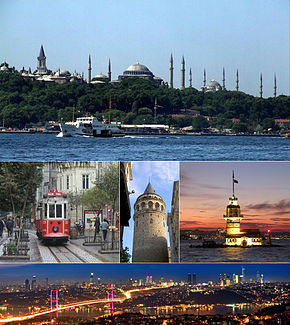 Istanbul, once known as the capital of capital
cities, has many unique features. It is the only city in the world to straddle two
continents, and the only one to have been a capital during two consecutive empires
- Christian and Islamic. Once was capital of the Ottoman Empire, Istanbul still
remains the commercial, historical and cultural pulse of Turkey, and its beauty
lies in its ability to embrace its contradictions. Ancient and modern, religious
and secular, Asia and Europe, mystical and earthly all co-exist here.
Istanbul, once known as the capital of capital
cities, has many unique features. It is the only city in the world to straddle two
continents, and the only one to have been a capital during two consecutive empires
- Christian and Islamic. Once was capital of the Ottoman Empire, Istanbul still
remains the commercial, historical and cultural pulse of Turkey, and its beauty
lies in its ability to embrace its contradictions. Ancient and modern, religious
and secular, Asia and Europe, mystical and earthly all co-exist here.
Its variety is one of Istanbul's greatest attractions: The ancient mosques, palaces,
museums and bazaars reflect its diverse history. The thriving shopping area of Taksim
buzzes with life and entertainment. And the serene beauty of the Bosphorus, Princes
Islands and parks bring a touch of peace to the otherwise chaotic metropolis.
Districts
Adalar, Avcılar, Bağcılar, Bahçelievler, Bakırköy, Beşiktaş, Bayrampaşa, Beykoz,
Beyoğlu, Eminönü, Eyüb, Fatih, Gaziosmanpaşa, Kadıköy, Kâğıthane, Kartal, Küçükçekmece,
Pendik, Sarıyer, Şişli, Ümraniye, Üsküdar, Zeytinburnu, Büyükçekmece, Çatalca, Silivri,
Şile, Esenler, Güngören, Maltepe, Sultanbeyli, and Tuzla.
The Bosphorus
Golden Horn:
This horn-shaped estuary divides European Istanbul. One of the best natural harbours
in the world, it was once the centre for the Byzantine and Ottoman navies and commercial
shipping interests. Today, attractive parks and promenades line the shores, a picturesque
scene especially as the sun goes down over the water. At Fener and Balat, neighbourhoods
midway up the Golden Horn, there are entire streets filled with old wooden houses,
churches, and synagogues dating from Byzantine and Ottoman times.
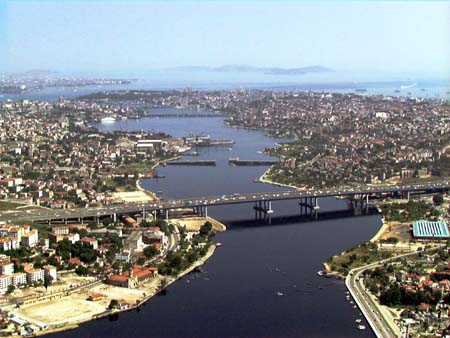
The Orthodox Patriarchy resides at Fener and a little
further up the Golden Horn at Eyup, are some wonderful examples of Ottoman architecture.
Muslim pilgrims from all over the world visit Eyup Camii and Tomb of Eyup, the Prophet
Mohammed's standard bearer, and it is one of the holiest places in Islam. The area
is a still a popular burial place, and the hills above the mosque are dotted with
modern gravestones interspersed with ornate Ottoman stones. The Pierre Loti Cafe,
at the top of hill overlooking the shrine and the Golden Horn, is a wonderful place
to enjoy the tranquility of the view.
Beyoğlu and Taksim:
Beyoglu is an interesting example of a district with European-influenced architecture,
from a century before. Europe's second oldest subway, Tunel was built by the French
in 1875, must be also one of the shortest – offering a one-stop ride to start of
Taksim. Near to Tunel is the Galata district, whose Galata Tower became a famous
symbols of Istanbul, and the top of which offers a tremendous 180 degree view of
the city.
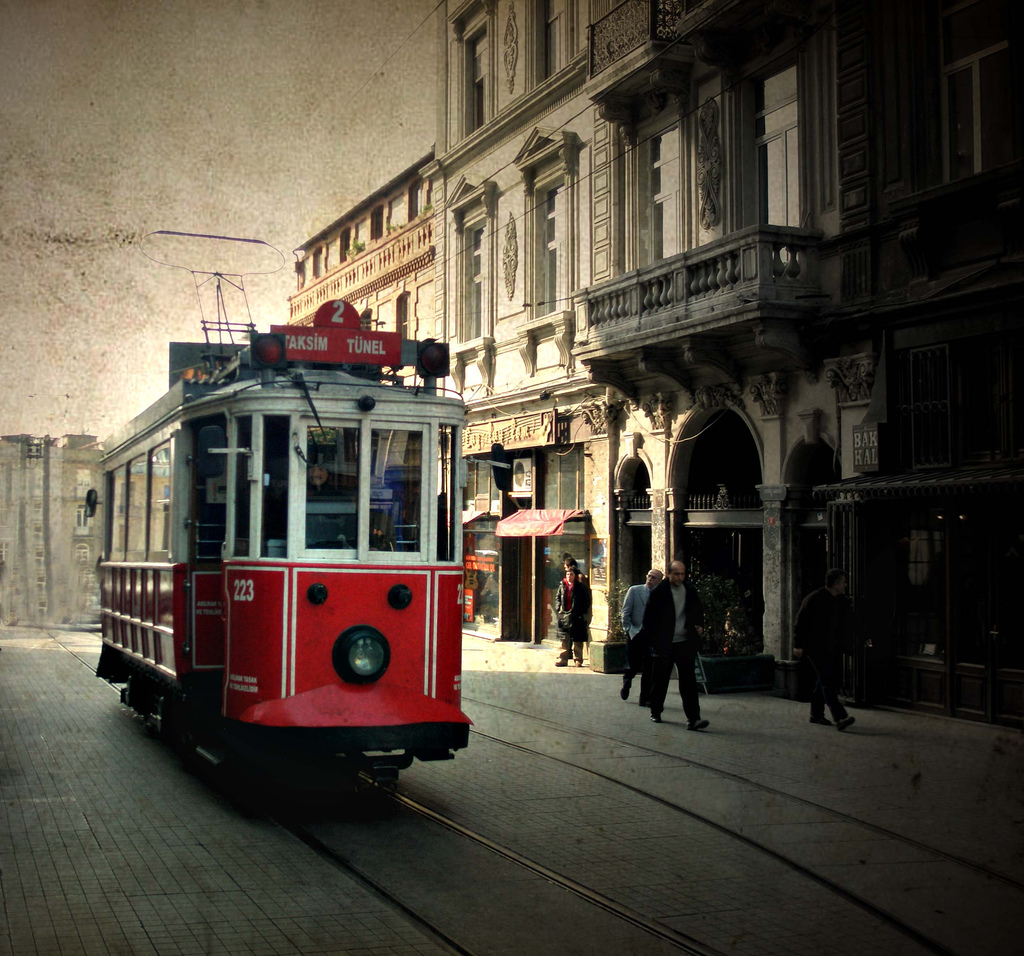 From
the Tunel area to Taksim square, is one of the city's focal points for shopping,
entertainment and urban promenading: Istiklal Cadesi is a fine example of the contrasts
and compositions of Istanbul; fashion shops, bookshops, cinemas, markets, restaurants
and even hand-carts selling trinkets and simit (sesame bread snack) ensure that
the street is packed throughout the day until late into the night. The old tramcars
re-entered into service, which shuttle up and down this fascinating street, and
otherwise the street is entirely pedestrianised. There are old embassy buildings,
Galatasaray High School, the colourful ambience of Balik Pazari (Fish Bazaar) and
restaurants in Cicek Pasaji (Flower Passage). Also on this street is the oldest
church in the area, St Mary's Draperis dating back to 1789, and the Franciscan Church
of St Antoine, demolished and then rebuilt in 1913.
From
the Tunel area to Taksim square, is one of the city's focal points for shopping,
entertainment and urban promenading: Istiklal Cadesi is a fine example of the contrasts
and compositions of Istanbul; fashion shops, bookshops, cinemas, markets, restaurants
and even hand-carts selling trinkets and simit (sesame bread snack) ensure that
the street is packed throughout the day until late into the night. The old tramcars
re-entered into service, which shuttle up and down this fascinating street, and
otherwise the street is entirely pedestrianised. There are old embassy buildings,
Galatasaray High School, the colourful ambience of Balik Pazari (Fish Bazaar) and
restaurants in Cicek Pasaji (Flower Passage). Also on this street is the oldest
church in the area, St Mary's Draperis dating back to 1789, and the Franciscan Church
of St Antoine, demolished and then rebuilt in 1913.
The street ends at Taksim Square, a big open plaza, the hub of modern Istanbul and
always crowded, crowned with an imposing monument celebrating Attaturk and the War
of Independence. The main terminal of the new subway is under the square, adjacent
is a noisy bus terminal, and at the north end is the Ataturk Cultural Centre, one
of the venues of the Istanbul Theatre Festival. Several five-star hotels are dotted
around this area, like the Hyatt, Intercontinental and Hilton (the oldest of its
kind in the city). North of the square is the Istanbul Military Museum.
Taksim and Beyoglu have for centuries been the centre of nightlife, and now there
are many lovely bars and clubs off Istiklal Cadesi, including some of the only gay
venues in the city. Beyoglu is also at the centre of the more bohemian arts scene.
Sultanahmet:
Many places of tourist interest are concentrated in Sultanahmet, in heart of the
Imperial Centre of the Ottoman Empire. The most important places in this area, all
of which are described in detail in the "Places of Interest" section, are Topkapi
Palace, Aya Sofia, Sultan Ahmet Camii (the Blue Mosque), the Hippodrome, Kapali
Carsi (Covered Market), Yerebatan Sarnici and the Museum of Islamic Art.
In addition to this wonderful selection of historical and architectural sites, Sultanahmet
also has a large concentration of carpet and souvenir shops, hotels and guesthouses,
cafes, bars and restaurants, and travel agents.
Ortaköy:
Ortakoy was a resort for the Ottoman rulers because of its attractive location on
the Bosphorus, and is still a popular spot for residents and visitors. The village
is within a triangle of a mosque, church and synagogue, and is near Ciragan Palace,
Kabatas High School, Feriye, Princess Hotel.
The name Ortakoy reflects the university students and teachers who would gather
to drink tea and discuss life, when it was just a small fishing village. These days,
however, that scene has developed into a suburb with an increasing amount of expensive
restaurants, bars, shops and a huge market. The fishing, however, lives on and the
area is popular with local anglers, and there is now a huge waterfront tea-house
which is crammed at weekends and holidays.
Sarıyer:
The first sight of Sarıyer is where the Bosphorus connects with the Black Sea, after
the bend in the river after Tarabya. Around this area, old summer houses, embassies
and fish restaurants line the river, and a narrow road which separates it from Buyukdere,
continues along to the beaches of Kilyos.
Sarıyer and Rumeli Kavağı are the final wharfs along the European side visited by
the Bosphorus boat trips. Both these districts, famous for their fish restaurants
along with Anadolu Kavagi, get very crowded at weekends and holidays with Istanbul
residents escaping the city.
After these points, the Bosphorus is lined with tree-covered cliffs and little habitation.
The Sadberk Hanim Museum, just before Sariyer, is an interesting place to visit;
a collection of archaeological and ethnographic items, housed in two wooden houses.
A few kilometres away is the huge Belgrade Forest, once a haunting ground of the
Ottomans, and now a popular weekend retreat into the largest forest area in the
city.
Üsküdar:
Relatively unknown to tourists, the suburb of Üsküdar, on the Asian side of the
Bosphorus, is one of the most attractive suburbs. Religiously conservative in its
background, it has a tranquil atmosphere and some fine examples of imperial and
domestic architecture.
The Iskele, or Mihrimah Camii is opposite the main ferry pier, on a high platform
with a big covered porch in front, often occupied by older local men watching life
around them. Opposite this is Yeni Valide Camii, built in 1710, and the Valide Sultan's
green tomb rather like a giant birdcage. The Cinili Mosque takes its name from the
beautiful tiles which decorate the interior, and was built in 1640.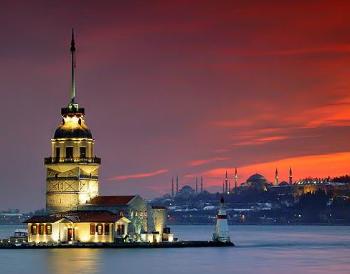
Apart from places of religious interest, Uskudar is also well known as a shopping
area, with old market streets selling traditional local products, and a good fleamarket
with second hand furniture. There are plenty of good restaurants and cafes with
a great views of the Bosphorus and the rest of the city, along the quayside. In
the direction of Haydarpasa is the Karaca Ahmet Cemetery, which is the largest Muslim
graveyard in Istanbul. The front of the Camlica hills lie at the ridge of area and
also offer great panoramic views of the islands and river.
Kadıköy:
Further down to the south along, the Bosphorus towards the Marmara sea, Kadıköy
has developed into a lively area with up-market shopping, eating and entertainment
making it popular especially with wealthy locals. Once prominent in the history
of Christianity, the 5th century hosted important consul meetings here, but there
are few reminders of that age. It is one of the improved districts of Istanbul over
the last century, and fashionable area to promenade along the waterfront in the
evenings, especially around the marinas and yacht clubs.
Bagdat Caddesi is one of the most trendy – and label-conscious – fashion shopping
streets, and for more down-to-earth goods, the Gen Azim Gunduz Caddesi is the best
place for clothes, and the bit pazari on Ozelellik Sokak is good for browsing through
junk. The Benadam art gallery remains in Moda district with many other foreing cusines,
restaurants and cafes.
Haydarpaşa:
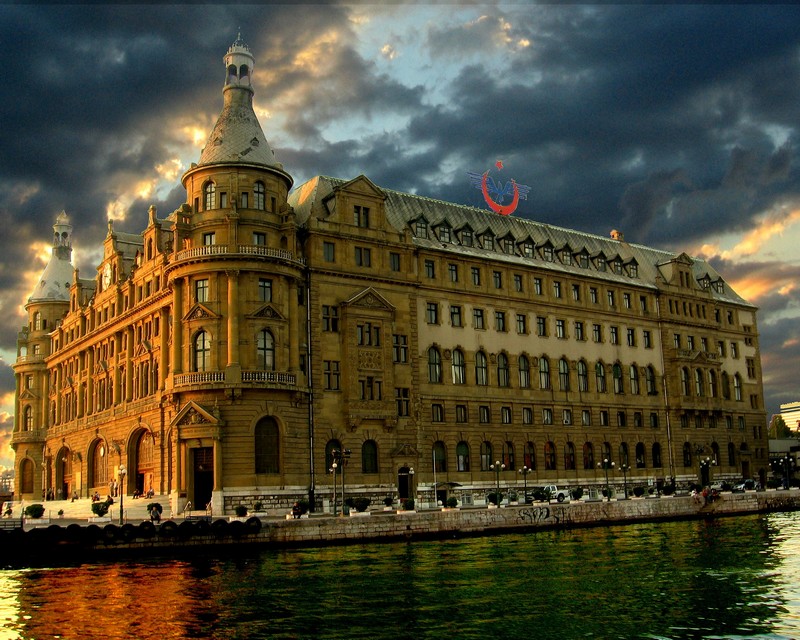
To
the north of Kadikoy is Haydarpasa, and the train station built in 1908 with Prussain-style
architecture which was the first stop along the Baghdad railway. Now it is the main
station going to eastbound destinations both within Turkey, and international. There
are tombs and monuments dedicated to the English and French soldiers who lost their
lives during the Crimean War (1854-56), near the military hospital. The north-west
wing of the 19th Century Selimiye Barracks once housed the hospital, used by Florence
Nightingale to care for soldiers, and remains to honour her memory.
Polonezköy:
Polonezköy, although still within the city, is 25 km. away from the centre and not
easy to reach by public transport. Translated as "village of the Poles", the village
has a fascinating history: It was established in 1848 by Prince Czartorisky, leader
of the Polish nationals who was granted exile in the Ottoman Empire to escape oppression
in the Balkans. During his exile, he succeeded in establishing a community of Balkans,
which still survives, on the plot of land sold to him by a local monastery.
Since the 1970s the village has become a popular place with local Istanbulites,
who buy their pig meat there (pig being forbidden under Islamic law and therefore
difficult to get elsewhere). All the Poles have since left the village, and the
place is inhabited now by wealthy city people, living in the few remaining Central
European style wooden houses with pretty balconies.
What attracts most visitors to Polonezkoy is its vast green expanse, which was designated
Istanbul's first national park, and the walks though forests with streams and wooden
bridges. Because of its popularity, it gets crowded at weekends and the hotels are
usually full.
Kilyos:
Kilyos is the nearest beach resort to the city, on the Black Sea coast on the European
side of the Bosphorus. Once a Greek fishing village, it has quickly been developed
as a holiday-home development, and gets very crowded in summer. Because of its ease
to get there, 25km and plenty of public transport, it is good for a day trip, and
is a popular weekend getaway with plenty of hotels, and a couple of campsites.
Şile:
A pleasant, small holiday town, Şile lies 50km from Üsküdar on the Black Sea coast
and some people even live there and commute into Istanbul. The white sandy beaches
are easily accessible from the main highway, lying on the west, as well as a series
of small beaches at the east end.
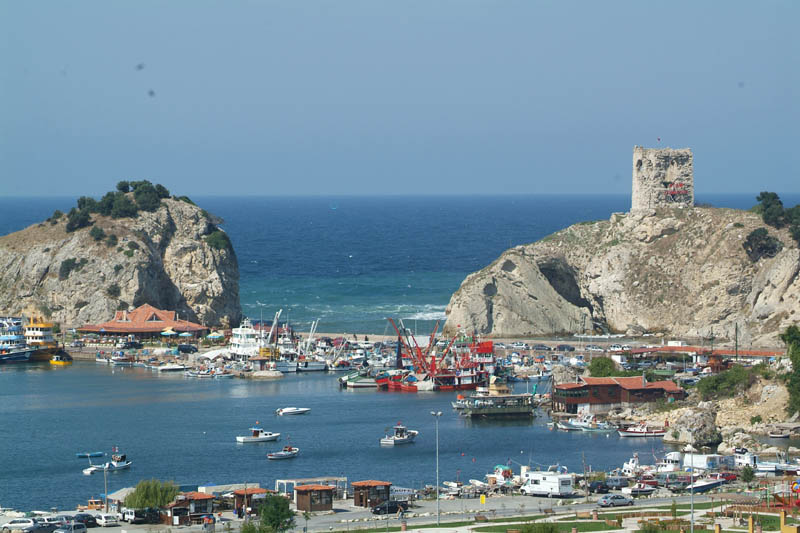
The town itself if perched on a clifftop over looking the bay tiny island. There
is an interesting French-built black-and-white striped lighthouse, and 14th century
Genoese castle on the nearby island. Apart from its popular beaches, the town is
also famous for its craft; Sile bezi, a white muslin fabric a little like cheesecloth,
which the local women embroider and sell their products on the street, as well as
all over Turkey.
The town has plenty of accommodation available, hotels, guest houses and pansiyons,
although can get very crowded at weekends and holidays as it is very popular with
people from Istanbul for a getaway, especially in the summer. There are small restaurants
and bars in the town.
Prince's Islands:
Also known as Istanbul Islands, there are eight within one hour from the city, in
the Marmara Sea. Boats ply the islands from Sirkeci, Kabatas and Bostanci, with
more services during the summer. These islands, on which monasteries were established
during the Byzantine period, was a popular summer retreat for palace officials.
It is still a popular escape from the city, with wealthier owning summer houses.
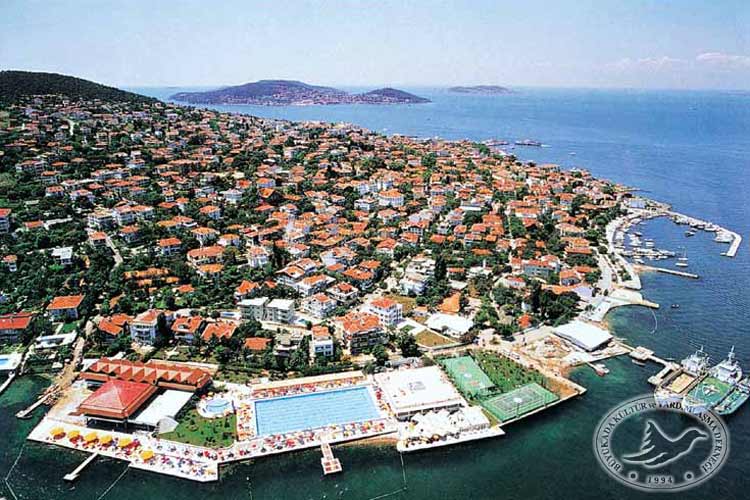 Buyukada
The largest and most popular one in Istanbul is Buyukada (the Great Island). Large
wooden mansions still remain from the 19th century when wealthy Greek and Armernian
bankers built them as a holiday villas. The island has always been a place predominantly
inhabited by minorities, hence Islam has never had a strong presence here.
Buyukada
The largest and most popular one in Istanbul is Buyukada (the Great Island). Large
wooden mansions still remain from the 19th century when wealthy Greek and Armernian
bankers built them as a holiday villas. The island has always been a place predominantly
inhabited by minorities, hence Islam has never had a strong presence here.
Buyukada has long had a history of people coming here in exile or retreat; its most
famous guest being Leon Trotsky, who stayed for four years writing 'The History
of the Russian Revolution'. The monastery of St George also played host to the granddaughter
of Empress Irene, and the royal princess Zoe, in 1012.
The island consists of two hills, both surmounted by monasteries, with a valley
between. Motor vehicles are banned, so getting around the island can be done by
graceful horse and carriage, leaving from the main square off Isa Celebi Sokak.
Bicycles can also be hired.
The southern hill, Yule Tepe, is the quieter of the two and also home of St George's
Monastery. It consists of a series of chapels on three levels, the site of which
is a building dating back to the 12th century. In Byzantine times it was used as
an asylum, with iron rings on the church floors used to restrain patients. On the
northern hill is the monastery Isa Tepe, a 19th century house.
The entire island is lively and colourful, with many restaurants, hotels, tea houses
and shops. There are very big well-kept houses, trim gardens, and pine groves, as
well as plenty of beach and picnic areas.
Burgazada It is a smaller and less infrastructured for tourists.The famous Turkish
novelist, Sait Faik Abasıyanık lived there, and his house has been turned into a
museum dedicated to his work, and retains a remarkable tranquil and hallowed atmosphere.
Heybeliada 'Island of the Saddlebag', because of its shape, is loved for its natural
beauty and beaches. It also has a highly prestigious and fashionable watersports
club in the northwest of the island. One of its best-known landmarks is the Greek
Orthodox School of Theology, with an important collection of Byzantine manuscripts.
The school sits loftily on the northern hill, but permission is needed to enter,
from the Greek Orthodox Patriarchate in Fener. The Deniz Harp Okulu, the Naval High
School, is on the east side of the waterfront near the jetty, which was originally
the Naval War Academy set up in 1852, then a high school since 1985. Walking and
cycling are popular here, plus isolated beaches as well as the public Yoruk Beach,
set in a magnificent bay.
There are plenty of good local restaurants and tea houses, especially along Ayyıldız
Caddesi, and the atmosphere is one of a close community.
Environment:
Wide beaches of Kilyos at European side of Black Sea at 25th km. outside the Istanbul,
is attracting Istanbul residents during summer months. Belgrade Forest, inside from
Black Sea, at European Side is the widest forest around Istanbul. Istanbul residents,
at week ends, come here for family picnic with brazier at its shadows. 7 old water
tank and some natural resources in the region compose a different atmosphere. Moğlova
Aqueduct, which is constructed by Mimar Sinan during 16th century among Ottoman
aqueducts, is the greatest one. 800 m. long Sultan Suleyman Aqueduct, which is passing
over Golf Club, and also a piece of art of Mimar Sinan is one of the longest aqueducts
within Turkey.
Polonezköy, which is 25 km. away from Istanbul, is founded at Asia coast during
19th century by Polish immigrants. Polonezköy, for walking in village atmosphere,
travels by horse, and tasting traditional Polish meals served by relatives of initial
settlers, is the resort point of Istanbul residents. Beaches, restaurants and hotels
of Şile at Black Sea coast and 70 km. away from Üsküdar, are turning this place
into one of the most cute holiday places of Istanbul. Region which is popular in
connection with tourism, is the place where famous Şile cloth is produced.
Bayramoğlu - Darıca Bird Paradise and Botanic Park is a unique resort place 38 km.
away from Istanbul. This gargantuan park with its trekking roads, restaurants is
full of bird species and plants, coming from various parts of the world.
Sweet Eskihisar fisherman borough, to whose marina can be anchored by yachtsmen
after daily voyages in Marmara Sea is at south east of Istanbul. Turkey's 19th century
famous painter, Osman Hamdi Bey's house in borough is turned into a museum. Hannibal's
tomb between Eskihisar and Gebze is one of the sites around a Byzantium castle.
There are lots of Istanbul residents' summer houses in popular holiday place 65
km. away from Istanbul, Silivri. This is a huge holiday place with magnificent restaurants,
sports and health centers. Conference center is also attracting businessmen, who
are escaping rapid tempo of urban life for "cultural tourism" and business - holiday
mixed activities. Scheduled sea bus service is connecting Istanbul to Silivri.
Islands within Marmara Sea, which is adorned with nine islands, was the banishing
place of the Byzantium princes. Today they are now wealthy Istanbul residents' escaping
places for cool winds during summer months and 19th century smart houses. Biggest
one of the islands is Büyükada. You can have a marvelous phaeton travel between
pine trees or have a swim within one of the numerous bays around islands!
Other popular islands are Kınalı, Sedef, Burgaz and Heybeliada. Regular ferry voyages
are connecting islands to both Europe and Asia coasts. There is a rapid sea bus
service from Kabataş during summers.